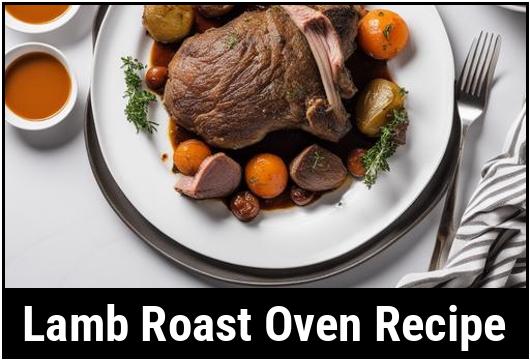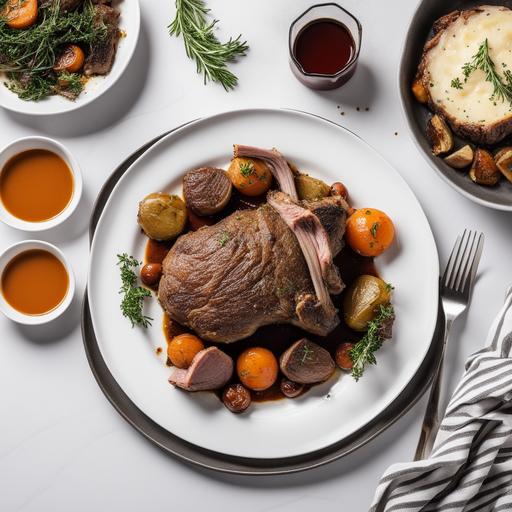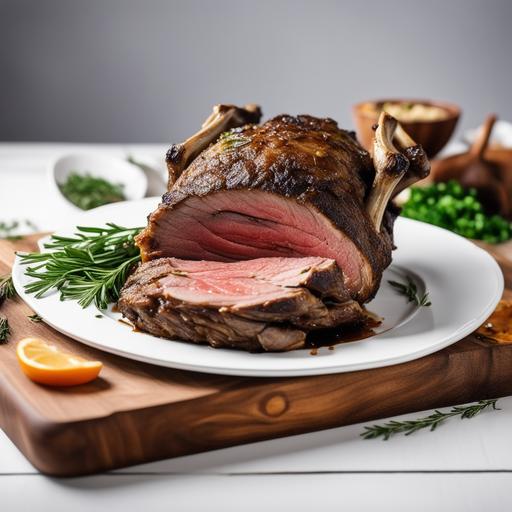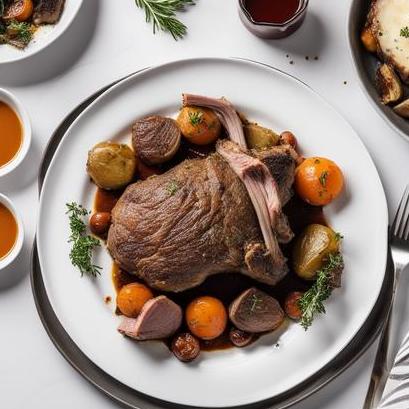
The Perfect Lamb Roast Oven Recipe: Indulge In A Culinary Delight
Lamb roast is a mouthwatering dish that strikes the perfect balance between tenderness and juiciness. With its succulent flavors and aromatic seasonings, a properly cooked lamb roast can truly be a showstopper at any gathering or special occasion. In this comprehensive guide, we will delve into the various aspects of preparing a lamb roast in the oven, from selecting the right cut to achieving the perfect doneness. Get ready to embark on a culinary journey like no other!
Understanding the Food Science Behind a Perfect Lamb Roast
Before we dive into the nitty-gritty of the cooking process, it is essential to understand the science behind a perfectly cooked lamb roast. Lamb is a tender meat that can become tough if overcooked, so precision is crucial. The key factors contributing to the tenderness and flavor of the lamb roast are:
-
Fat Content: The marbling of fat throughout the lamb roast adds richness and moisture to the meat, preventing it from drying out.
-
Connective Tissue: Collagen, a connective tissue found in lamb, melts during cooking, resulting in a tender and succulent texture.
-
Cooking Temperature: Achieving the right internal temperature while cooking determines the doneness of the lamb roast and ensures it remains tender and juicy.
Selecting the Perfect Cut of Lamb for Roasting
When it comes to choosing the ideal cut of lamb for roasting, there are a variety of options available. Here are a few popular choices that are well-suited for oven-roasting:
-
Leg of Lamb: This is a classic option, often seen as the centerpiece for festive dinners. A whole leg of lamb offers a balance between tenderness and flavor.
-
Lamb Shoulder: Known for its robust flavor, the shoulder cut is slightly fattier and benefits from slow roasting, resulting in meltingly tender meat.
-
Rack of Lamb: A more elegant choice, the rack consists of tender meat and delicious fat. It is perfect for smaller gatherings or more formal occasions.
When purchasing lamb, opt for cuts that are bright pinkish-red in color, with firm and fine textured meat. Avoid any cuts that feel slimy or have an offensive odor, as this indicates spoilage.
Cleaning and Preparing the Lamb Roast

Before you begin preparing your lamb roast, it is essential to give it a thorough cleaning to remove any impurities. Follow these steps to ensure your lamb roast is fresh and ready for seasoning:
-
Rinsing: Rinse the lamb roast under cold water to remove any excess blood or debris. Pat it dry gently with paper towels.
-
Trimming: Trim any excess fat from the surface of the roast, but be sure to leave a thin layer intact to enhance the flavor and prevent dryness during cooking.
-
Tying: If your lamb roast is boneless, tie it with kitchen twine at regular intervals to help it retain its shape during cooking.
Essential Tips for a Flawless Lamb Roast

To elevate your lamb roast to perfection, consider the following important tips:
-
Marination: Marinating the lamb roast for a few hours or overnight with herbs, spices, and your preferred marinade will infuse it with delicious flavors and enhance its tenderness.
-
Resting Time: After cooking, allow the lamb roast to rest for 10-15 minutes under a foil tent. This allows the juices to redistribute throughout the meat, resulting in a moist and succulent roast.
-
Temperature Control: Invest in a reliable meat thermometer to ensure accurate temperature readings. This will help you achieve the desired level of doneness without the risk of undercooking or overcooking.
Variations to Suit Your Taste

One of the most exciting aspects of a lamb roast is its versatility. You can customize the seasoning and flavor profile to match your personal taste preferences. Here are a few variations to consider:
-
Mediterranean-Style: Season your lamb roast with a blend of Mediterranean herbs such as rosemary, thyme, oregano, and garlic. Drizzle with olive oil for an extra touch of richness.
-
Moroccan-Spiced: Infuse your lamb roast with the aromatic spices of Morocco, using blends like ras el hanout, cumin, cinnamon, and paprika. Roast it with a medley of vegetables for a complete meal.
-
Asian-Inspired: Create a fusion of flavors by marinating your lamb roast with soy sauce, ginger, garlic, and a hint of chili. Serve with steamed rice or noodles and stir-fried vegetables for an Asian twist.
Feel free to experiment with different herbs, spices, and marinades to create your own signature lamb roast to suit any occasion.
Checking for Doneness: A Crucial Step

Achieving the perfect level of doneness for your lamb roast is crucial to ensure a delightful dining experience. Here are some guidelines for checking the internal temperature:
-
Rare: Cook to an internal temperature of 125°F (51°C) for a rosy pink center.
-
Medium Rare: Aim for an internal temperature of 135°F (57°C) for a warm pink center.
-
Medium: Achieve an internal temperature of 145°F (63°C) for a slightly pink center.
-
Well Done: For those who prefer a well-done roast, cook until the internal temperature reaches 160°F (71°C) and above.
Remember that the lamb’s internal temperature will continue to rise a few degrees while it rests, so aim for slightly lower temperatures to account for this.
A Classic Lamb Roast Oven Recipe
Now that we have covered the essentials, let’s get down to the specifics of a classic lamb roast oven recipe. Here’s a step-by-step guide:
Ingredients:
-
1 leg of lamb (5-6 lbs)
-
4 cloves of garlic, minced
-
2 tablespoons fresh rosemary, chopped
-
2 tablespoons fresh thyme leaves
-
Salt and pepper, to taste
Instructions:
-
Preheat your oven to 325°F (163°C).
-
In a small bowl, combine the minced garlic, chopped rosemary, thyme leaves, salt, and pepper.
-
Rub the mixture evenly over the surface of the lamb roast, ensuring all sides are coated.
-
Place the lamb roast on a roasting rack or elevated wire rack set inside a roasting pan.
-
Roast in the preheated oven for approximately 20 minutes per pound of meat, or until the desired internal temperature is reached.
-
Once cooked, remove the lamb roast from the oven and tent it loosely with foil. Let it rest for 10-15 minutes before carving.
-
Carve the lamb roast into thin slices and serve with your favorite sides, such as roasted potatoes or grilled vegetables.
Overcooking and Undercooking: Avoiding Common Pitfalls
Though we strive for the perfect lamb roast, mistakes can happen in the cooking process. Here’s how to navigate two common pitfalls:
-
Overcooking: Overcooking can cause the lamb roast to become dry and tough. To prevent this, monitor the internal temperature closely and remove the roast from the oven as soon as it reaches your desired level of doneness.
-
Undercooking: Undercooking lamb can be equally disappointing. If you find that your roast is undercooked, simply return it to the oven for a few more minutes, regularly checking the internal temperature until it reaches the desired doneness.
Remember, practice makes perfect, and with time and experience, you’ll become a master at achieving the ideal lamb roast every time.
In Conclusion
Preparing a lamb roast in the oven is more than a cooking method; it’s an art form. By selecting the right cut, understanding the food science, and employing the proper techniques, you can create a lamb roast that surpasses expectations. Remember, the journey to culinary excellence requires patience, precision, and a hunger for experimentation. So gather your ingredients, preheat that oven, and embark on a culinary adventure that is sure to leave a lasting impression on all who indulge. Bon appétit!
Sources
FAQS On Lamb Roast Oven Recipe
What Type Of Lamb Should I Use For A Roast?
For a roast, it’s best to choose a shoulder, leg, or rack of lamb. These cuts are perfect for slow roasting in the oven and will result in tender, juicy meat.
How Should I Season The Lamb For Roasting?
Season the lamb generously with salt, pepper, and any other herbs or spices you prefer. A classic combination includes rosemary, garlic, and thyme. Make sure to rub the seasoning all over the lamb for even flavor.
What Temperature And Timing Should I Use For Roasting The Lamb?
Preheat your oven to 375°F. For a 3-4 pound lamb roast, cook for about 20 minutes per pound for medium-rare doneness. Use a meat thermometer to ensure the internal temperature reaches 145°F for medium-rare or 160°F for medium.
Should I Cover The Lamb While Roasting?
It’s best to not cover the lamb while roasting, as this will allow the exterior to become nicely browned and crispy. If you find the lamb is browning too quickly, you can tent it loosely with aluminum foil.
How Should I Carve And Serve The Lamb Roast?
Allow the lamb to rest for about 15 minutes after removing it from the oven. Then, carefully carve it into slices and serve with your choice of sides, such as roasted vegetables or a fresh salad. Enjoy!



